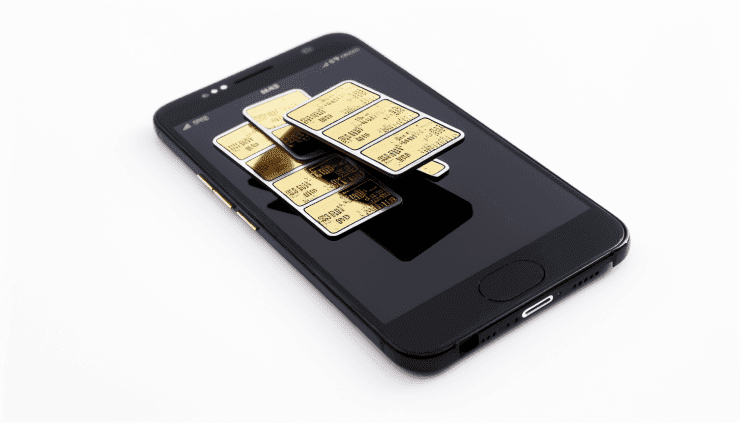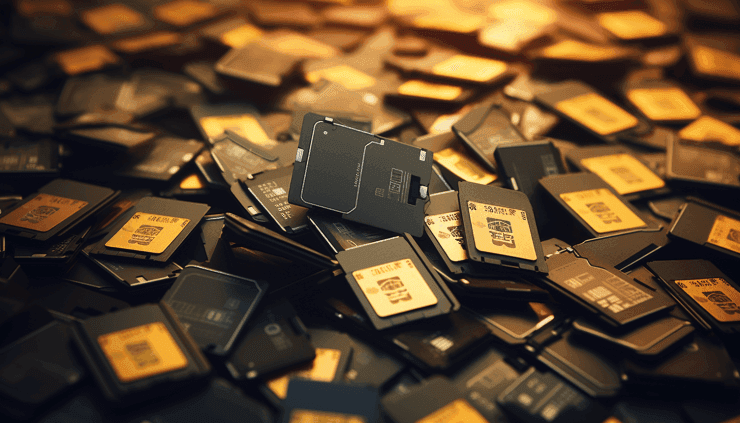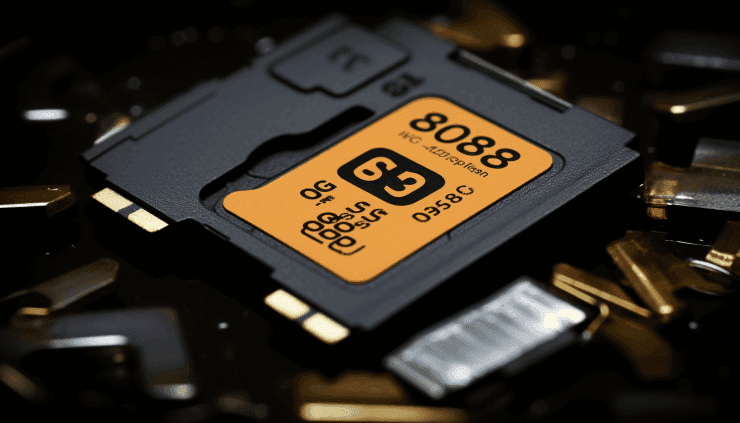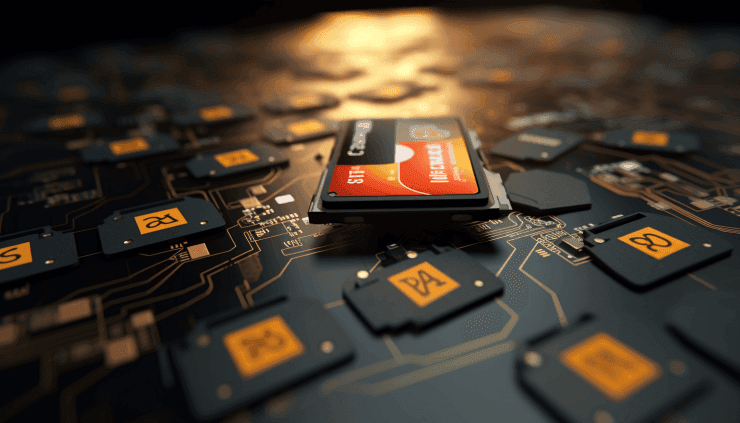
Table of contents
Share
Share
Yesim virtual SIM card
Get a 2-euro discount for your first purchase with the code
In this article, we will tell you what types of SIM cards are used in smartphones of popular manufacturers. You will learn about the sizes of SIM cards and which phone models support them. We will also give you some simple tips to find out what type of SIM card you need for your device.
Different SIM cards types for your phone
There are the following kinds of SIM cards for phones:
- standard;
- mini-SIM;
- micro-SIM;
- nano-SIM;
- eSIM;
- iSIM.
Each type differs in size, with newer phone models often using the more compact nano-SIM. There are also modern innovative technologies — eSIM and iSIM.
Standard
The standard format, aka 1FF, appeared in 1991. The chip could be compared in size to a bank plastic card. Its parameters:
- length 85.6 mm;
- width 53.98 mm;
- thickness 0.76 mm.
At the time it was introduced, this type of SIM card was considered progressive, because it could be moved from phone to phone without going to the operator's office. The standard format lasted until 1996. This was the time when cellular communication became more affordable, and all related equipment was progressing towards reducing sizes — the size of the standard 1FF became over-dimensioned.
mini-SIM

mini-SIM is a type of SIM card that was introduced in 1996. Until the introduction of more compact formats, it was considered standard for most phones.
The characteristics of the mini-SIM are:
- size: 25 mm × 15 mm;
- thickness: 0.76 mm;
- contact pads: 6 contacts.
Now such a SIM card is already obsolete and is not used in modern smartphones. But some phones released before 2012 support the old format, these are:
- iPhone 4 and previous models;
- Samsung Galaxy S2 and earlier;
- older models of BlackBerry, Nokia, HTC and other manufacturers.
Read also: What is eSIM: what is it for and how to use it
micro-SIM

micro-SIM is a SIM card type developed by ETSI (European Telecommunications Standards Institute). It was first introduced in 2003. Micro-SIM is made to reduce the size of the traditional SIM card, to free up extra space in smartphones and other mobile devices.
Characteristics of micro-SIM:
- size: 15 x 12 mm makes it smaller than its predecessor, the standard SIM card, but larger than the modern nano-SIM format;
- thickness: 0.76 mm;
- contact pads: 8 gold contacts arranged in two rows of four contacts each.
Today micro-SIM is almost completely out of use, but some older and budget models continue to support this format, such as:
- iPhone 4;
- Samsung Galaxy S3, S4, S5;
- Google Nexus 4, Nexus 5;
- HTC One M7, M8, M9;
- Sony Xperia Z1, Z2, Z3;
- Nokia Lumia 920, 1020, 1520.
nano-SIM

nano-SIM is the smallest type of SIM card in smartphones and other devices for connecting to mobile networks. It was introduced in 2012 and was the successor to the micro-SIM. The new SIM was developed by Apple and nano-SIM appeared in their device iPhone 5 for the first time in 2012.
The format differs from its predecessors by its smaller size, which makes it possible for smartphone manufacturers to produce thinner and more compact chips. In terms of functionality, nano-SIM is the same as large SIM card formats.
Characteristics of nano-SIM:
- size: 12.3 mm x 8.8 mm;
- thickness 0.67 mm;
- contact pads: 6 metal contacts, arranged in two rows of 3 contacts each.
Almost all smartphones released after 2012 use nano-SIM as the standard format. Some of the most popular models with this kind of SIM card are:
- iPhone, starting with the iPhone 5;
- Samsung Galaxy, S-series;
- Google Pixel 4 and 5;
- OnePlus 9 and Nord;
- Xiaomi Mi 11 and Redmi Note 10;
- Oppo Find X3 and Oppo Reno 6;
- Huawei P40 and Mate 40;
- Sony Xperia 1 III and 5 II.
Read also: SIM vs eSIM: what are the differences and which is better?
eSim

Here is the information about what SIM card type comes in the most modern smartphones. The eSIM embedded virtual card is the technology that has been available for use in smartphones and other devices since 2013. Features and benefits of eSIM technology:
- users can switch carriers without physically replacing the SIM card — just download a carrier profile to the device;
- easy to use — the virtual card is already integrated into the device by the manufacturer.
To use the convenient eSIM technology, install Yesim mobile application, choose a suitable tariff and connect to the mobile Internet without the need to buy SIM cards of local operators in most countries of the world. To see the full list of devices that support eSIM virtual cards, please visit this page.
iSIM
iSIM is a microchip integrated into a smartphone, the next step in the evolution of SIM cards. Today it is considered the most efficient, flexible and modern network equipment that can work in portable gadgets.
This type of SIM card is embedded in a tamper-resistant element (TRE) in the system-on-chip (SoC) of the device. Activation is wireless through an industry-wide secure protocol.
The iSIM is tiny in size — less than one square millimeter. The new card occupies much less space in the device than a SIM card or eSIM, this is an opportunity for the device manufacturer to use the freed space more functionally.
The iSIM is suitable for use in smart watches as well as battery-powered IoT devices. In the second case, it removes the restriction to work only via Wi-Fi.
In addition, iSIM basically removes the size and shape restrictions of most portable electronic devices. This is especially advantageous for 5G mobile internet where low-power global networks are involved.
Advantages of iSIM:
- ultra-compact size;
- security — iSIM is customizable according to a device requirements;
- low power requirements — no separate microprocessor is needed for operation;
- 2G, 3G, 4G and 5G compatibility.
Rumor has it that the number of iSIM-enabled devices will increase to 500 million by 2025, and while the main gadget for this card type will be a smartphone, iSIMs will also be heavily used in laptops, tablets, augmented reality devices and a wider range of gadgets for the Internet of Things.
Share
Share
FAQ
Why are SIM cards shrinking in size?
A smaller size is necessary for compatibility with new models of mobile devices that are becoming thinner and chunkier. SIM cards shrank to enable smartphone manufacturers to create more ergonomic designs and increase competitiveness in the market.
How do I know which type of SIM card I need for my smartphone?
There are a few simple ways to do it:
- look at the packaging or user manual, which usually indicates the type of SIM card you need;
- hardware information and specifications of the smartphone are available in the manuals;
- check the device settings in the network settings section;
- use an internet search and enter the following query: «SIM card type for (smartphone model)»;
- if you cannot find the information yourself, contact your service provider.
Recommended eSIMs
Pay & Fly
Unlimited data. Pay as you go
Europe & UK eSIM
33 countries
United States eSIM
from $1.72 / day
United Kingdom eSIM
from $1.88 / day
Turkey eSIM
from $1.88 / day
Germany eSIM
from $1.88 / day
France eSIM
from $1.88 / day
Italy eSIM
from $1.88 / day
Spain eSIM
from $1.88 / day
Israel eSIM
from $1.80 / day
Japan eSIM
from $1.28 / day
Indonesia eSIM
from $1.88 / day
